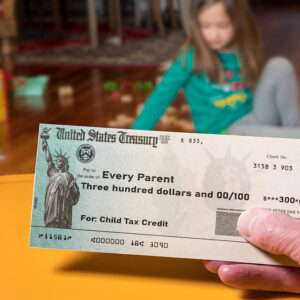On July 15, millions of moms and dads across America found cash in their bank accounts thanks to the Child Tax Credit (CTC) included in President Joe Biden’s American Families Plan. Parents received $250 or $300 per child “without having to take any action,” the White House notes. Democrats have been quick to take credit.
“For the first time, it’s the middle class that’s getting a tax cut. That is a HUGE win for our economy and our working families. We need to make sure that our #ChildTaxCredit is permanent,” tweeted Rep. Chrissy Houlahan (D-Chester).
During a press conference with Sen. Cory Booker (D-N.J.) and Speaker of the House Nancy Pelosi (D-Calif.), Senate Majority Leader Chuck Schumer (D-N.Y.) lauded the CTC as “a substantial and potentially life-altering tax cut for American families.”
And Pennsylvania Senator Bob Casey participated in a July 14 Democratic event “highlightinng the local impact of Democrats’ new tax cut for middle-class families,” according to a statement from the Pennsylvania Democratic Party. Casey also re-tweeted a message from Biden calling the CTC “one of the largest middle-class tax cuts ever.”
But is it? Not “the largest,” but an actual “tax cut?”
Sen. Marco Rubio (R-Fla.) doesn’t think so. He calls the CTC a “radical expansion of the federal welfare state.”
“By next tax season, some households with no working adults will receive more than $10,000 in these payments. No work required. Just free money on top of America’s existing safety net,” Rubio wrote.
According to the White House, the American Rescue Plan increased the Child Tax Credit from $2,000 per child to $3,000 per child for children over the age of six and from $2,000 to $3,600 for children under the age of six, and raised the age limit from 16 to 17. “All working families [emphasis added] will get the full credit if they make up to $150,000 for a couple or $112,500 for a family with a single parent.”
That includes families who pay no net federal income taxes.
The IRS also sees the CTC as something other than a tax cut. The IRS says although both reduce the amount owed to the federal government, a tax cut reduces the percentage that is paid to the IRS based on income, while a tax credit reduces the amount owed after that percentage has already been calculated.
What’s more, the 2021 CTC is “fully refundable,” meaning that even if you have no income or didn’t pay taxes last year, you are still eligible to receive the credit.
“Parts of the [American Rescue Plan] Act do, in fact, reduce income tax burdens on many filers,” the National Taxpayers Union Foundation (NTUF) says, “However, the bulk of the ‘tax cuts’ underlying [the claims] do not actually reduce anyone’s taxes. Instead, they show up in the budget as spending, including the ‘recovery rebate’ stimulus checks.”
The CTC is not considered income, and will not be subject to additional taxes. This mirrors other stimulus payments that have been sent out since the COVID-19 pandemic began.
Or as Rubio put it, “Why [do] they keep calling this program ‘tax relief’ when it goes to people who pay no taxes?”
For Americans who do pay income taxes, it’s possible some may have to pay back part or all of the payments when it comes time to file taxes next year.
For example, if a parent ends up receiving more than they’re entitled to under the CTC, that money will be paid back to the government. If the number of qualifying children changed or children moved into a different age bracket, it’s possible some parents will receive too much with the advance payments.
Ironically, the CTC will end up costing taxpayers more in the end, says the National Taxpayers Union (NTU). The Treasury Department estimates that if the program were extended for four years, it would cost roughly $112 billion per year, totaling around $449 billion.
Sen. Mitt Romney (R-Utah) has proposed several ideas to make the CTC more responsible, including reforms and changes to existing programs such as the state and local tax deduction (SALT), Earned Income Tax Credit (EITC), and other overlapping programs. Romney’s proposal would also make the CTC more of an anti-poverty measure, eliminating payments to Americans who, in some cases, make six-figure salaries.
As Democrats push the CTC to be a permanent fixture, the NTU notes that not all of that money will be reserved for those who truly need it.
Upcoming legislation “spend[s] hundreds of billions of dollars, at minimum, on public benefits that flow to upper-middle-class or wealthy households that do not urgently need the support.” Part of that legislation is the “extraordinarily generous [CTC] that flows, in part, to wealthy households.”


